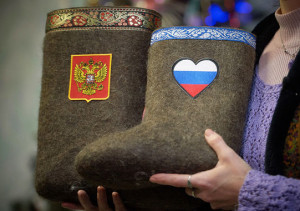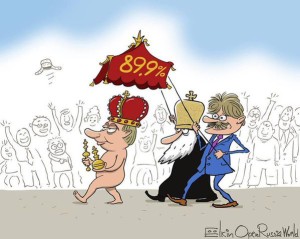
Many Russian officials have been using the current wave of patriotic intolerance toward anything foreign–especially Western–to boost their PR image. “Import substitution” has almost become the most popular phrase in the country. In September 2015, an import substitution specialized exhibition in Moscow–for some reason dubbed “international”– was visited by Prime Minister Dmitri Medvedev himself.
The embargo banning food imports from European Union, United States, Canada, and Australia, introduced by Russian government as an asymmetrical response to Western sanctions against Russia’s for its invasion to Ukraine, has not yet provoked public unrest. Russia’s Agriculture Minister, Alexander Tkachev, believes that in five years Russia will be able to produce almost everything domestically, the only exceptions being citrus fruits, bananas, and date palms.
Although other, more reasonable ministers cautiously suggest limiting the bans to those that have already been imposed, without extending them to all products–especially those used in industrial production and health care – the majority of Russian citizens support the idea of extending the current embargo to include other product categories. Thus, according to the Public Opinion Foundation, “64 percent of Russians are convinced that in the coming years, Russian industry will be quite able to supply the population with quality clothing and shoes”.
In his speech at the St. Petersburg International Economic Forum in May 2014, President Putin talked about the necessity to “give the market back to domestic manufacturers”. Prime Minister Medvedev keeps up with the president’s rhetoric, not to mention some governors, who are vitally interested in the development of light industry in their regions. The Russian Union of Entrepreneurs of Textile and Light Industry, a major trade association, and the Russian Association of Textile Workers are suggesting cutting down clothing, shoes and textile imports. The pro-government Ekspert weekly business magazine chimes in with the same message.
On March 31, 2015, Russia’s Industry and Trade Ministry issued an ordinance “On adopting an import substitution plan in the light industry sector of the Russian Federation”. These measures have so far affected only official and work uniforms—not everyday clothing—but the tendency is evident. In mid-October, the state-controlled Channel One television network aired an unambiguous news report on how “shoes manufactured in Russia and Belarus fit us anatomically”.
Russians over 35 years of age have no trouble imagining what the Russian government’s accelerated import substitution program might lead to, because they can still remember enormous clothing and shoes shortages in the Soviet Union. Shoes and clothing items were distributed among organizations, rationed out, and sold at extremely high prices on the black market, and people stood in lines for days in order to buy Adidas sneakers that were manufactured in Russia under a German license. According to experts, Russia, with a population of 141 million people, annually manufactures only 33 million pairs of shoes, including children’s shoes. Over the long term, the situation with socks and tights promises to be slightly better: according to the Strategic Research Program of the Textile and Light Industry Technology Platform for the period from 2013 to 2020, there will be some two pairs per person per year of socks and tights by the year 2017. And even according to the Public Council on Small Business Development under the auspices of the governor of St. Petersburg, “the country’s mobilization needs in light industry production are only met up to 17-36 percent, which is contrary to the legislation concerning the security of the state.”
 Today, the output of Russia’s light industry only meets less than 25 percent of the needs of the domestic market. According to the Industry and Trade Ministry, this causes Russia to lose 1.1 percent of its GDP every year, since the other 75 percent of the goods are imported.
Today, the output of Russia’s light industry only meets less than 25 percent of the needs of the domestic market. According to the Industry and Trade Ministry, this causes Russia to lose 1.1 percent of its GDP every year, since the other 75 percent of the goods are imported.
According to the aforementioned Union of Entrepreneurs of Textile and Light Industry, there are just 458 textile and light industry enterprises in Russia. It is not clear, however, how many of them work on Russian equipment or Russian supplies. In the city of Ivanovo, once the Russian textile capital, very little fabric is produced today—and the fabric that is being produced is made from imported materials. The only reason for hope is that the embargo affects Western made goods, whereas most clothes and shoes are imported into Russia from China and other south-east Asian countries. Turkey too has always been a large-scale supplier of popular consumer goods into Russia, but Russian airstrikes in Syria could seriously compromise this mutually beneficial trade relationship.
It does not even bear thinking about what would happen if, tomorrow, the popularly supported President Putin launches a military action in another neighboring state, and squares of Russian cities are filled with large numbers of Russian patriots dressed in domestically produced military uniforms and tarpaulin boots.





